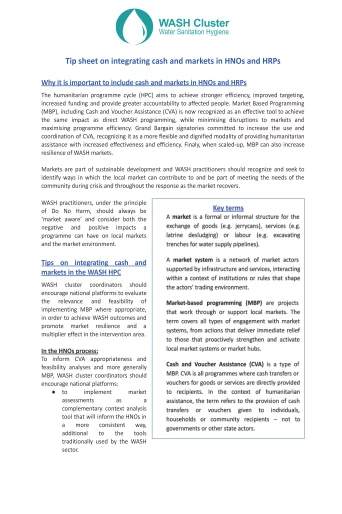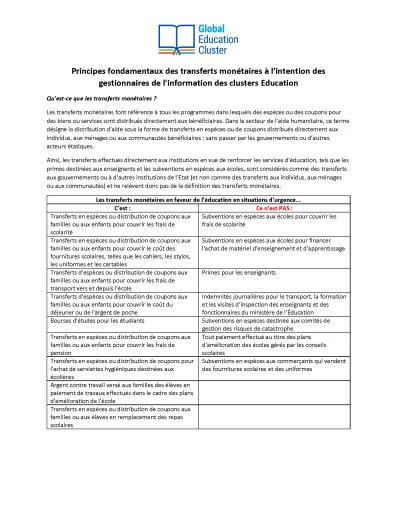Transferts monétaires et mobilité humaine
Les transferts monétaires sont souvent utilisés lors de crises afin de répondre aux besoins des personnes migrantes. Dans cette page, vous trouverez des ressources sur les transferts monétaires et la migration.

La Croix-Rouge se prépare à fournir une aide humanitaire aux migrant·es de la caravane sur le point de quitter le Honduras pour le Guatemala.
©Johannes Chinchilla / FICR.
Conflits, crises économiques et catastrophes sont autant de raisons ayant contraint des personnes à fuir et à traverser des frontières dans des conditions éprouvantes et risquées, en quête de sécurité et de moyens de subsistance. En 2020, le nombre de personnes déplacées de force s’est envolé au niveau sans précédent de plus de 80 millions de personnes, soit près du double du nombre enregistré il y a une dizaine d’année. Cette tendance s’aggrave et les effets du changement climatique menacent de déplacer jusqu’à 200 millions de personnes d’ici 2050.
L’assistance monétaire est de plus en plus utilisée afin de répondre aux besoins des personnes en situation de déplacement. On y a eu recours à grande échelle dans différents contextes de migration, en Europe en 2015 jusqu’au Venezuela pour « los caminantes ». Elle a également été utilisée dans d’autres crises migratoires, notamment en Amérique centrale, au Sahel, en Méditerranée et dans la Corne de l’Afrique. L’assistance monétaire est à l’heure actuelle l’une des principales formes d’aide apportée aux populations déplacées en Ukraine et dans les pays voisins.
Il existe une myriade de perspectives et de définitions concernant le mot « migrant·e » et la façon dont les humanitaires doivent agir. C’est pourquoi nous ne choisissons pas une définition unique pour le moment, étant donné que les discussions sur l’assistance monétaire et la migration en sont encore à leurs prémices et que le langage évolue encore.
Documenter et partager les données probantes donnera lieu à des interventions plus efficaces. Cette page contient une sélection de ressources utiles concernant la migration et le recours à l’assistance monétaire. Elle sera mise à jour au fil des discussions ayant lieu dans les espaces humanitaires des transferts monétaires.
Priorités actuelles
Afin de contribuer aux progrès relatifs à cet enjeu, nous nous engageons à :
- soutenir la création de données probantes aux niveaux régional et mondial ;
- contribuer aux solutions pratiques visant à mettre en œuvre les transferts monétaires auprès des personnes migrantes ;
- organiser des discussions sur les enjeux majeurs basées sur des données probantes.
Contenu récent

ASP Gap Analysis Template
Guidelines and Tools
This tool was developed to support the development of a roadmap for Adaptive Social Protection(ASP)in Indonesia. The goal of the “GapAnalysis” is to help governments and partners understand how far the current situation, that is current efforts in the context of ASP, aligns or diverges from the...

Cash and Voucher Assistance Essentials for Nutrition Cluster Information Managers
Guidelines and Tools
CVA refers to all programmes where cash transfers or vouchers for goods or services are directly provided to recipients. In the context of humanitarian assistance, the term refers to the provision of cash transfers or vouchers directly to individuals, household or community recipients; not to governments...

Tip sheet on integrating cash and markets in HNOs and HRPs
Guidelines and Tools
The humanitarian programme cycle (HPC) aims to achieve stronger efficiency, improved targeting, increased funding and provide greater accountability to affected people. Market Based Programming (MBP), including Cash and Voucher Assistance (CVA) is now recognized as an effective tool to achieve the same...

Cash and Voucher Assistance Guidelines for Lao PDR
Guidelines and Tools
Cash and voucher assistance is becoming increasingly popular in Lao PDR in delivering humanitarian assistance, rehabilitation and development focused projects. In supporting the cash and voucher assistance agenda in Lao PDR, the Cash Working Group was established as a working group for local and regional...

Conseils pour l’intégration des transferts monétaires dans l’Aperçu des Besoins Humanitaires et les Plans de Réponse Humanitaire – HNO et HRP
Guides et outils
Le recours aux TM a considérablement augmenté ces dernières années, années, passant de 10,6 % de l’aide humanitaire internationale internationale en 2016 à 19 % en 2020. Aujourd’hui, les TM sont largement reconnus comme une modalité plus souple et plus digne de fournir de l’aide humanitaire...

The Learning Brief: Cash assistance for mitigation of gender-based violence in Somalia
Report
In 2021, Somalia witnessed a catastrophic increase in the number of vulnerable women and girls exposed to Gender-Based Violence (GBV) risks. Natural disasters and armed conflicts resulted in multiple displacements, forced evictions, and the destruction of livelihoods, health facilities, GBV service sites...

CVA for Health Outcomes – Position Paper
Policy paper
The RCRCM CVA for Health Outcomes Technical Working Group Position Paper on Cash for Health Outcomes explores how CVA (a form of demand side financing) can be used to support health outcomes, as a complement to supply side interventions, and highlight some of the key considerations.

Principes fondamentaux des transferts monétaires à l’intention des gestionnaires de l’information des clusters education
Rapport
Ce document répond à vos questions de responsable sur les TM pour le cluster éducation.

“Pinning down moving targets”: Adapting humanitarian cash programmes to the multi-pronged crises in Lebanon
Report
Whilst most humanitarian responses across the globe have had to navigate the impact of the Coronavirus pandemic, in Lebanon the challenges related to COVID-19 emerged on top of an unprecedented protest movement, political instability, a rapid deterioration of the economy and the increasingly protracted...

Cash and Voucher Assistance for Protection Outcomes in Mine Action
Report
Despite growing evidence that Cash and Voucher Assistance (CVA) can be a useful tool, where appropriate, to enhance the protection and resilience of individuals, households, and communities affected by crisis, Cash and Voucher Assistance is not widely used within Humanitarian Mine Action (HMA). This study...

Cash. Dignity. Agency.
Video
Watch the videos here Displaced people face higher rates of gender-based violence before, during, and after they are forced to move. The Women’s Refugee Commission (WRC) explores how cash transfers can be used in response to gender-based violence and its potential to help displaced persons, including...

Cash and Voucher Assistance for Adolescents: An evidence review of how cash and voucher assistance can achieve outcomes for adolescents in humanitarian settings
Report
During crises, the institutions, systems and community cohesion that normally support adolescent development break down. Humanitarian response often fails to take the necessary steps to mitigate and counteract the disadvantages that adolescent girls and boys in crisis face – including access to...

Cash transfer and child protection: An integrated approach to address the needs of unaccompanied and separated adolescents in the Central African Republic
Report
This report assesses Plan International’s Monetary Transfer and Child Protection Project in Central African Republic. It aims to understand the strengths and weaknesses of the programme, including implementation challenges and successes, benefits and associated risks for beneficiaries,and to identify...

Cash Transfer and Education: Supporting basic education for Syrian refugees and Egyptian host communities
Report
This report assesses Plan International’s Tawasol: Learning for Coexistence Project in Egypt to understand its strengths and weaknesses, including implementation challenges and successes, risks and benefits for beneficiaries, and any needs for continued capacity building. Plan International – with...

How to Incorporate Cash and Voucher Assistance into a Nutrition Response
Guidelines and Tools
There is a growing recognition that Cash and Voucher Assistance (CVA), i.e. the provision of cash transfers and vouchers to targeted beneficiaries, can contribute to improving maternal and child nutrition by impacting on the underlying determinants of adequate nutrition. The main purpose of this Guidance...

Beware of the Crocodile: Quantitative Evidence how Universal Old Age Grants distort the Social Assistance Systems of Low-Income Countries
Policy paper
This paper compares two approaches to establishing or improving social assistance systems in low and lower-middle income countries. Taking Eswatini and Lesotho as examples of the mainstream approach, it provides quantitative evidence on the social protection outcomes of social assistance systems that are...

Multi-Sector Market Assessment Guidance and Toolkit
Guidelines and Tools
Markets play a vital role in the lives of displaced persons and their host communities. Humanitarian actors increasingly rely on market-based programme responses to help crisis affected populations meet their needs through local markets. Market assessments should be an essential and integral part of the...

SPACE Economics of Early Response and Resilience to COVID-19: Ethiopia
Guidelines and Tools
The 2013 and 2018 Economics of Early Response and Resilience (TEERR) studies demonstrated the significant economic gains of investing in a more proactive response to crises. The first study was funded by DFID in 2013, followed by a more in-depth analysis in 2018 with USAID in three countries – Ethiopia,...

Gender Equality and Gender-Based Violence Risk Mitigation in Cash and Voucher Assistance: Vanuatu Case study
Report
The case study was created with the inputs of Oxfam Vanuatu and UNFPA Vanuatu. It demonstrates the meaningful connection of cash and voucher assistance and gender at a response level. Vanuatu is one of the world’s most remote locations and particularly vulnerable to cyclones and other natural hazards....

Establishing a Cash Working Group and GBV Sub-Cluster task force: NW Syria Case Study
Report
The case study was created with the inputs of two Cash Working Group leads and the GBV Turkey cross-border Sub-Cluster leads in the Northwest Syria response. The case study demonstrates an example of meaningful linking of gender-based violence response and cash and voucher assistance. As Cash and Voucher...